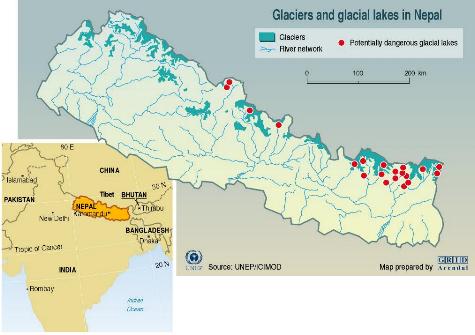Tiempo Climate Cyberlibrary
Climate Vulnerability and Adaptation in Nepal
 |
Anil Raut presents a summary of the climate
change impacts confronting Nepal and discusses
adaptation measures that are being
undertaken.
|
|
The author is working on climate change issues
with Winrock International, Nepal. He has worked in
the past as a researcher with EnvironmentNEPAL.
|
The climate of Nepal
varies from arctic to tropical within a 200km span from
north to south. This variability of climatic conditions
within a short distance and limited area has blessed this
beautiful mountainous country with a high diversity of
flora and fauna as well as a plentiful supply of water
resources.
Nepal has nearly 4.5 per cent of the world's
mammalian species and over nine per cent of bird species.
The immense bio-climatic diversity in Nepal supports more
than thirty- five forest types giving rise to 5,833 species
of flowering plants, including around 248 species of
endemic plant and 700 species of medicinal plants.
Nepal's landmass is also home to 185 species of
mammals, 847 species of birds, 645 species of butterflies,
170 species of fishes and other animals. At this time, 26
species of mammals, nine species of birds and three species
of reptiles are declared endangered.
Nepal has a negligible share in global emissions of
greenhouse gases. This, together with the fact that its
fragile mountain ecosystem is particularly vulnerable to
climate change, is why Nepal needs to focus on adaptation
measures rather than those of mitigation.
Nepal's major natural resources, biodiversity and
water, are at the forefront of climate vulnerability.
Analysis of mean monthly river discharges, for example,
shows that global warming would melt snow cover on the
mountain tops earlier, thus shifting the peak discharge
month from August to July. This could lead to increased
flooding as well as more pronounced variations in water
availability throughout the year.
There are a number of sectors in which climate change
impacts on water resources will affect Nepal. These include
natural disasters, hydropower, irrigation, and domestic
water usage. Of these, it is the potential increase in
climate-related disasters, particularly from glacial lake
outburst floods, that is perhaps the most prevalent
threat.
The formation and growth of glacial lakes is closely
related to deglaciation. Valley glaciers usually contain a
supra-glacial pond which can substantially increase in size
through the melting of glaciers and any warming in climate.
The moraine walls that act as dams are structurally weak
and unstable. Growing pressure on this natural dam can lead
to catastrophe through glacial lake outburst floods.
Out of 2,323 glacial lakes in Nepal, twenty lakes have
been found to be potentially dangerous because of the
apparent potential for glacial lake outburst floods. The
most significant such event, in terms of recorded damage,
occurred on August 4th 1985. A glacial lake outburst flood
caused a ten to fifteen metre high surge of water and
debris to flood down the Bhote Koshi and Dudh Koshi rivers
for ninety kilometres destroying, amongst many things, the
Namche Small Hydro Project.
|

|
|
Glaciers and glacial
lakes in Nepal. Red indicates potentially dangerous
glacial lakes
© GRID-Arendal
|
Climate also plays a major role in determining the
feasibility of hydropower projects. Potential changes in
precipitation and temperature that are likely to affect
runoff must always be taken into account. Both the Bhote
Koshi and the Dudh Koshi rivers have their headwaters high
in the Himalayas. Nepal has the potential to generate
around 43,000 megawatts of hydroelectricity taking account
of the contribution of all the country's rivers. But if
a river's discharge is always unpredictable there will
continually be problems and failure in any design of
hydropower plants. Not only will there be problems in
designing hydropower plants to account for a highly
variable water supply, but extreme events such as glacial
lake outburst floods will also physically damage or destroy
the power plants.
As 80 per cent of the Nepalese population depends on
agriculture, any changes in climatic conditions affecting
rainfall patterns will have an adverse impact on the
livelihoods of most of the Nepalese people, which means
that there is always the high risk of food insecurity.
The majority of the population is directly dependent on
a few crops such as rice, maize, and wheat. Most of the
farmers are reliant on rainwater for irrigation as the
country lacks major facilities for artificial irrigation.
Farmers, therefore, prepare their cropping calendar
according to the experience they have with both the
intensity and the time of rainfall. Any significant changes
to this pattern will lead to loss in crop yield.
There is a clear need to educate the farmers on the
possible effects of climate change, particularly in regard
to changing rainfall patterns. A cropping technique for
rice such as the System of Rice
Intensification, together with crop diversification, is
one important alternative that should be promoted,
requiring less irrigation than conventional farming
practice. The government also needs to provide assistance
to farmers in establishing alternate means of
irrigation.
Vegetation patterns would also be altered by changes in
temperature and precipitation. This, in turn, would affect
biodiversity. Vegetation patterns and distribution would be
different under any changed climatic scenario. Not only
would the diversity of plants be affected but also the
animals which live within a particular habitat.
Increased disasters, particularly from floods related to
glacier melt, would directly impact on human health.
Diseases such as malaria and Japanese encephalitis may also
increase their impact through expanding to new regions. One
area that would be at risk of an increase in diseases is
the lower flat plain of Nepal, the Terai region, which is
warmer than the mountain regions. The current lack of
primary healthcare for large portions of the population
also contributes to their vulnerability. Future climate
change and the possible impact on human health needs to be
considered now and national support, education and
comprehensive coping strategies should be initiated through
the establishment of widespread primary healthcare
centres.
As a response to the increasing awareness of Nepal's
vulnerability to climate change, numerous adaptation
options for various sectors have been proposed and many
already implemented.
One major project that focuses on glacial lake outburst
flood mitigation has been undertaken in the Tsho Rolpa
glacial lake area. With the support of The Netherlands,
the Nepalese government undertook a project to drain and
reduce the depth of the Tsho Rolpa glacial lake by three
metres. This reduced the risk of a glacial lake outburst
flood by twenty per cent. A major aspect of the design was
that a channel was cut into the moraine, and a gate was
constructed to allow water to be released as necessary.
For other potential glacial lake outburst flood sites,
an early warning system has been proposed for the people
living downstream. In conjunction with an engineering
project that was undertaken between 1998 and 2002 to reduce
the risk of a glacial lake outburst flood occurring on Tsho
Rolpa, an early warning system was simultaneously
established in nineteen villages downstream of the
Rolwaling river. Local villagers have been actively
involved in the design of this system to ensure that they
feel safe from the potential glacial lake outburst flood
event and at the same time be aware about the potential
damage.
Certain glacial lake outburst flood mitigation measures
can provide additional benefits. For example,
micro-hydropower and drained off water could also be used
to supplement dry season flows. This strategy could also
help to maintain adequate water levels in downstream
ecosystems to protect valuable fish stocks and in the
supply of water for local usage.
It is too soon to comment on the results of any
government action on these adaptation measures. At the
moment, one important activity that needs to be urgently
focused on is the identification of the nation's
vulnerable sites and sectors and proposals need to be
devised for appropriate adaptation measures. Civil society
in Nepal must also play its part in finding ways to
integrate adaptation to the possible impacts of climate
change with the current development process.
Disclaimer
The views expressed in this article are those of the author
and do not explicitly represent those of the author's
affiliated organization.
Further information
Anil K Raut, PO Box 12362, Kathmandu, Nepal. Email:
araut@winrock.org.np
or ankraut@wlink.com.np.
Web: www.winrock.org.np.
On the Web
Nepal's Initial National Communication under the UNFCCC
is available as a 2.8Mb
download. The Tiempo Climate Cyberlibrary presents a
listing of theme sites on mountains and climate
change.

